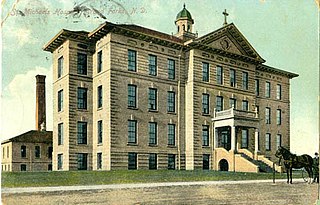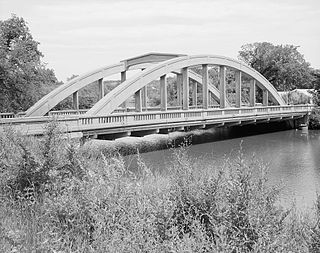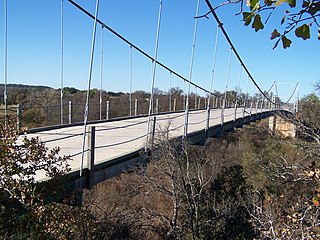Related Research Articles
The Kansas City Bridge Company was a bridge building company that built many bridges throughout the Midwest United States in the early 1900s. The company was founded in 1893 and ceased business around 1960.

The King Iron Bridge & Manufacturing Company was a late-19th-century bridge building company located in Cleveland, Ohio. It was founded by Zenas King (1818–1892) in 1858 and subsequently managed by his sons, James A. King and Harry W. King and then his grandson, Norman C. King, until the mid-1920s. Many of the bridges built by the company were used during America's expansion west in the late 19th century and early 20th century, and some of these bridges are still standing today.

Dibley House, also known as Graf House, is a property in Fargo, North Dakota that was listed on the National Register of Historic Places in 1980. The listing included two contributing buildings on an area of less than 1 acre (0.40 ha). The listing included two contributing buildings on an area of less than 1 acre (0.40 ha).

George Hancock was an architect active in North Dakota, Montana and Minnesota.

Canton Bridge Company was a firm that was later incorporated into the American Bridge Company. The firm was established in Canton, Ohio in 1892 and became one of the nation's biggest bridge-builders during the early 20th century. It designed and/or built many bridges that later became listed on the U.S. National Register of Historic Places (NRHP).
The Northwood Bridge, also known as Goose River Bridge, was a historic 56-foot-long (17 m) bridge across the Goose River about 1.5 miles (2.4 km) from Northwood, North Dakota. Dating from 1906, it was significant as a relatively rare example of a half-hip type of Pratt pony truss bridge. It was also significant as the oldest surviving documented bridge in Grand Forks County, North Dakota. The bridge was listed on the National Register of Historic Places in 1997. It was destroyed by an overweight load in 2019.

The Ost Valle Bridge is a bridge near Thompson, North Dakota that was listed on the National Register of Historic Places in 1997. It crosses an unnamed tributary of the Red River, about one mile west of the Red River itself. It is "one of the two oldest documented bridges in Grand Forks County that were built by long-term county bridge builder, the Jardine & Anderson".
The Iowa Bridge Company was a company that designed and built many bridges that are listed on the U.S. National Register of Historic Places.

The Missouri Valley Bridge & Iron Co., also known as Missouri Valley Bridge Company, was a engineering, construction, and steel fabrication firm that operated through the late nineteenth and most of the twentieth centuries. It was based in Leavenworth, Kansas, with a WWII facility in Evansville, Indiana.
Standard Bridge Company was an American bridge company that was "one of the most important bridge building firms in Nebraska history."
The Beaver Creek Bridge near Finley, North Dakota, also known as Newburgh Bridge, is a Pratt through truss bridge that was built in 1913. It is a pinned Pratt pony truss bridge and is "the oldest documented bridge in Steele County constructed by a long-term county bridge builder, the Fargo Bridge and Iron Company. Fargo built bridges in Steele County in almost every year between 1904 and 1920."
The Elliott Bridge, in North Dakota, United States, also known as Souris River Bridge, was built by Fargo Bridge & Iron Co. in 1902. The bridge "was designed to replace a county-owned ferry boat that had been operating across the Souris River at 'the Elliott Place.'" It was listed on the National Register of Historic Places in 1997. It is owned and maintained by McHenry County.

The Lisbon Bridge over the Sheyenne River in Lisbon, North Dakota, also known as Sheyenne River Bridge, was built by the Works Project Administration in 1936. It was listed on the National Register of Historic Places in 1997.
The Nesheim Bridge near McVille, North Dakota is a Pratt through truss structure that was built in 1904 to cross the Sheyenne River. It was listed on the National Register of Historic Places in 1997.
The West Antelope Bridge near Flora, North Dakota is a pin-connected Pratt pony truss structure that was built in 1907. It was listed on the National Register of Historic Places in 1997.

The West Park Bridge across the Sheyenne River in Valley City, North Dakota is a concrete false arch structure that was built in 2007. Together with the corresponding East Park Bridge, it brings Valley City's 4th Street across an oxbow of the Sheyenne River. The bridge is a sympathetic replacement for a historic bridge, built in 1924, that was listed on the National Register of Historic Places in 1997.

The Rainbow Arch Bridge at Valley City, North Dakota, also known as Main Street Bridge, is a Marsh Rainbow Arch structure that was built in 1925. One year later it was designated as part of an overlap with US 10 and US 52, but was replaced by business routes of both roads and later given the additional overlap of Interstate Business Route 94 which gradually replaced the U.S. business routes. It was listed on the National Register of Historic Places on February 27, 1997, but was demolished and replaced in 2004.

The Virginia Bridge & Iron Co., also known as Virginia Bridge Company, was a bridge company based in Roanoke, Virginia.

The Pittsburgh-Des Moines Steel Company, and often referred to as Pitt-Des Moines Steel or PDM was an American steel fabrication company. It operated from 1892 until approximately 2002 when its assets were sold to other companies, including Chicago Bridge & Iron Company. The company began as a builder of steel water tanks and bridges. It also later fabricated the "forked" columns for the World Trade Center in the 1960s, and was the steel fabricator and erector for the Gateway Arch in St. Louis. A number of its works are listed on the National Register of Historic Places.

Austin Bridge Company was a bridge company based in Dallas, Texas. It fabricated and built a number of bridges that are listed on the U.S. National Register of Historic Places. It eventually became part of Austin Industries.
References
- ↑ "Fargo Bridge & Iron Co. of Fargo, North Dakota". Bridgehunter.com. Retrieved February 1, 2020.
- ↑ "Francis E. Dibley (1860-1910)". Duluth News-Tribune - August 31, 1910. Retrieved February 1, 2020.
- ↑ Mark Hufstetler (December 10, 1996). "National Register of Historic Places Multiple Property Documentation: Historic Roadway Bridges of North Dakota". National Park Service.
- 1 2 3 4 5 6 7 8 9 10 "National Register Information System". National Register of Historic Places . National Park Service. March 13, 2009.
- ↑ Mark Hufstetler (December 10, 1996). "National Register of Historic Places Registration: Beaver Creek Bridge". National Park Service. Retrieved 2011-06-09.